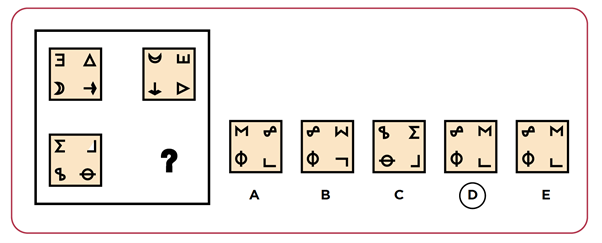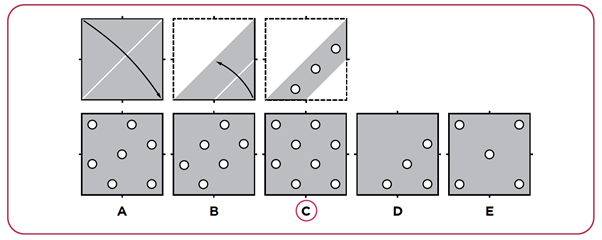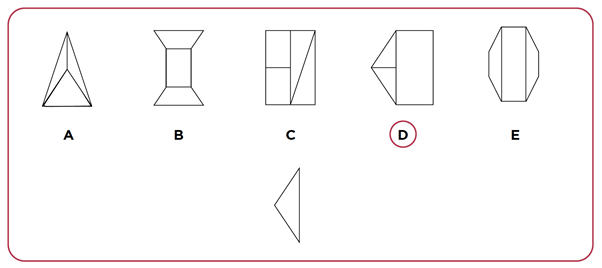Welcome to Mosaic Fit‘s latest guest article on CAT4 skills highlighting
School Entrance Tests CAT4 Skills Guide
A CAT 4 overview of the best practice CAT step-by-step process for CAT4 tutors and CAT4 teachers to follow is:
- Primarily to determine the reasoning qualities of a child and compares his or her progress to the children of the same age and groups.
- Aligned with the above as a means of tracking in detail an individual student’s learning progress.
- But also to show teachers how best to teach individual students.
- Also, CAT4 score comparisons are made. We explain how and why below.
Have CAT4 questions?
ASK our Founder, Rob Williams, ANY SCHOOL ENTRY TEST QUESTIONS at passedpapers@gmail.com
CAT4 practice recommendations
- Firstly, top CAT4 practice tests.
- Secondly, the BEST Year 11 CAT4 practice tests for sixth form entry 2024.
- Thirdly, our Year 7 CAT4 test samples.
- Recommended CAT4 test practice and THE BEST 2024 CAT4 test practice.
- How to improve my CAT4 reasoning skills, and to practice specific CAT4 question types.
- Finally, why not try our advanced practice CAT4 papers to help you pass your 2024 CAT4 assessment.
What does each CAT4 sub-test involve?
Each CAT4 test battery consists of eight short CAT4 sub-tests with each focusing on different cognitive abilities. You can find test practice for each CAT4 sub-test at these CAT4 skill section-by-section CAT4 links:
- CAT4 Figure Classification test practice
- and CAT4 Figure Matrices practice tests
- CAT4 Verbal Classification test practice
- and CAT4 Verbal Analogies practice tests
- CAT4 Number Analogies test practice
- and CAT4 Number Series practice tests
- CAT4 Figure Analysis test practice
- and CAT4 Figure Recognition practice tests
You can learn how to improve each CAT4 sub-test scores in the next CAT4 section below.
Learn how to improve your CAT4 sub-tests scores
- How to improve your Figure Classification CAT4 score
- Learn how to improve your Figure Matrices CAT 4 result
- How to improve your Verbal Classification cat4 score
- Learn how to improve your Verbal Analogies CAT4 result
- How to improve your Number Analogies CAT4 score
- Learn how to improve your Number Series CAT4 result
- How to improve your Figure Analysis CAT4 score
- Learn how to improve your Figure Classification CAT4 result
How the CAT4 will be used by your child’s school
The CAT4 provides several opportunities, including identifying your child’s cognitive strengths.
Most schools typically use CAT4 results to provide:
- A concrete perspective on the achievement of the pupil and can also be identified.
- To reveal a true hidden potential of a student. However, once an assessment has been done, all the numbers can be. analysed for a deeper level of understanding of how well the children are performing. At the same time, there are some. questions such as how will a parent know if something needs to be done about their child’s CAT 4 performance.
Best practice using the CAT4
Before getting into all of this discussion, it is important to understand what CAT4 does. It provides:
- an all-around profile of the student’s ability so that any kind of support can be targeted.
- the right level of challenge and attempts to make some of the most informed decisions about the progress of an individual and also their target attainment.
- details on strengths and weaknesses.
How are CAT4 score comparisons made?
- Different CAT4 comparisons are made using the raw score and that can be obtained from checking how many CAT 4 answers were attempted correctly.
- These CAT4 raw scores are then compared to the performance of the other CAT4 pupils from the same age group, This allows the CAT 4 normative scores to be determined.
- On the other hand, the standard age score or SAS is the score of each age group’s average and is set to 100 and the standard deviation is set to 2.
ok. So, What if two pupils from different age groups receive the same SAS?
Then it can be claimed that they have done equally well when they are being compared to others of the same age group.
Furthermore, a student who is receiving the same CAT4 score on two different batteries can be said to have performed equally well on both and compared to others students of the same group.
Using CAT4 scores for learning interventions
in fact a deeper level analysis of CAT4 results are used to plan learning interventions. We describe below examples of using the CAT4 for:
- Interpreting the CAT4 scores of ‘Calculation-Masked’ pupils.
- CAT 4 score interpretation of ‘Maths Seesaw’ pupils.
- Interpreting the CAT4 scores of ‘Fuel and Fly’ pupils.
Using the CAT4 with Verbal Deficit Pupils
Usually these children have greater potential than they show and for having a language barrier or not speaking a local language, these verbal deficit children are considered below average.
There should be a common system in place that identifies the issues faced by these students and bring in a language that is suitable for all of these students.
For example, a student who has a CAT4 verbal score of 90 and a CAT4 non-verbal of 110 can be said to have a verbal deficit of 20.
However, if a child has a verbal score of 110 and a non-verbal of 130, then a deficit of 20 will indicate something completely different. The child has an above-average verbal score but it will still lag behind their cognitive reasoning. It means that they will struggle to communicate how gifted they are.
Using the CAT4 with ‘Calculation-Masked’ Children
Calculation-masked children are quite the opposite of verbally deficit children and one can compare it to their CAT4 verbal and CAT4 non-verbal scores. One should be looking for a significantly lower non-verbal CAT4 score.
Such masked children usually have lower non-verbal meaning and they can speak better than they can understand. In a classroom full of students, masked students will have the ability to speak quite well. Plus, their verbal abilities will be able to cover a lot of misconceptions.
They can disguise their actual understanding of a concept.
CAT4-based Adaptations
- There is very less about interventions and more about being aware of the students who have any such imbalance. Asking them the ‘why’ behind their statement.
- Then getting them to explain what they understand will result in figuring out what they have learned.
- Furthermore, this might also eradicate several misconceptions that the students might have. Every teacher needs to understand what every student is dealing with.
- Then if it is something quite serious, then it is also their responsibility to fix it. All students should have an equal learning process.
Using the CAT4 with ‘Maths Seesaw’ Children
- Maths Seesaw Children is calculated by comparing a quantitative score of a child with their CAT4 spatial score.
- The ideal, is that a child is balanced.
- However, some children can attain an imbalance between their understanding of number and space/shape.
So, what are CAT4’s implications in this case?
- Well, high CAT4 spatial when combined with low quantitative CAT4 scores indicate that pupil will learn better utilising concrete resources for grasping maths concepts.
- On the other hand, a child with low spatial and high quantitative will have the capability to easily pick up abstract concepts.
- However, they can find difficulty applying this to concrete resources.
Making appropriate CAT4 score-based interventions
Those teachers, who use the CAT4, can utilise the strength of children for developing their weaknesses. If a student has inclination towards abstract mathematics, then abstract method can be taught to them. Also, encouraging them to apply it utilising images and concrete materials like counters.
Using the CAT4 with ‘Fuel and Fly’ Children
Fuel and Fly children have a CAT4 non-verbal score of 120 or more combined with a CAT4 verbal score of 120 and above. Based on this score, fuel and fly children are evaluated.
These are high achievers who require challenging learning interventions courses. Such children not only have high CAT4 verbal and high CAT4 non-verbal skills but can pick-up new learning very quickly. In summary, they’ve the cognitive ability and language skills to excel.
So, yes, these children prefer challenging activities. For building their knowledge, the use of mastery style activities can be effective as it will allow them to problem solve, explain and justify. Focus on building their peer and self-evaluation skills can be useful for their development and improvement.
CAT4 score interpretation summary
In summary, we’ve shown how helpful the CAT4 report scores are for identify learning gaps and which strength(s) to focus on. It is also crucial to develop weaker areas and keeping children aware of their progress and results so that they can improve.
Want to improve your CAT4 reasoning skills set?
- Better your Quantitative reasoning skills
- IMPROVE YOUR MATHS skills
- Learn Maths skills
- PRACTICE your Maths skills
- CAT4 Quantitative Reasoning skills test practice
- IMPROVE YOUR ENGLISH resources 16+
- CAT4 verbal reasoning test skills
- Practice your English
- CAT4 spatial reasoning
- Spatial Reasoning CAT4 skills test practice
- 11 plus Non-Verbal Reasoning practice tests
- Non-Verbal Reasoning CAT4 skills test practice
WANT TO IMPROVE your analytical thinking?
or your LITERACY SKILLS?
Practice your Critical thinking skills

We also offer free CAT4 non-verbal reasoning skills resources. For example, our popular Passed Papers You Tube channel‘s CAT4 video guide.
Planning your CAT4 test practice step-by-step
Or if the CAT4 test practice is unsuitable then you will find our extensive School Entrance exam practice tests here:
- Establish How to interprete a CAT 4 results report.
- Learn what the different CAT 4 sections look like.
- Practice with the correct year CAT 4 test for your own child.
- Also, please do try our CAT4 test practice and parents guide to the CAT4.
Which four cognitive skills does the CAT4 assess?
The CAT4 requires knowledge of four cognitive skills:
Interpreting CAT4 scores
The CAT4 consists of four test batteries, each of which contains two tests for all but the youngest children. These batteries and tests are described below.
CAT 4 Verbal reasoning battery
In the Verbal Classification test, each question presents three words that are all similar in some way. This test assesses:
- general verbal reasoning and the
- ability to extract general principles from specific examples by
- identifying similarities and relationships between the concepts.
- general knowledge (for example, that an ankle is a joint),
- word knowledge (for example, that ‘cold’ can mean a virus or a low temperature)
- language development (for example, that some words can be verbs or nouns).
- how to use words like ‘although’ or ‘moreover’.

In the Verbal Analogies test, each question presents a verbal analogy in the form of ‘A-B: C-_’. Students have to work out how the first pair of words is related to each other and then select from five answer options the one that completes the second pair.
These questions involve two elements to the reasoning:
- First, students have to look for similarities. Plus, differences between the first pair. For example the second thing is an element of the first or a descriptive term for the first.
- Second, they have to duplicate that relationship starting with the third word presented.

Questions have been written to maximise the students’ flexibility in identifying and using concepts rather than taxing their background knowledge or vocabulary.
CAT4 Quantitative reasoning battery
In the Number Analogies test, each question presents three pairs of numbers, such as ‘4-6, 8-10, 9-_’. Students have to work out how the pairs of numbers are related and then complete the third pair by selecting the answer from the five options presented.

In the Number Series test, students have to work out the rule underlying the progression in the number series in each question and then select the next number in the series from the five options presented.
This test assesses the same underlying basic reasoning processes and number facility as Number Analogies.

CAT4 Nonverbal reasoning battery
In the Figure Classification test, each question presents students with three separate figures. They have to:
- Identify the conceptual link or underlying characteristic that all three figures have in common.
- Select the one figure from five answer options that goes with the first three.
This test assesses the ability to identify similarities, differences and relationships between elements.

In the CAT4 Figure Matrices test:
- each question presents a figural analogy in the form of ‘A-B, C-_’. Students have to work out how the first pair of figures is related to each other.
- CAT4 respondents then select from five answer options the one that completes the second pair.

The CAT4 Nonverbal Reasoning Battery questions:
- do not make use of words or numbers,
- have geometric and figural elements which bear little direct relationship to formal educational instruction.
- emphasise the discovery of, and flexibility in, manipulating relationships expressed in figural designs.
CAT4 Spatial ability battery
In the CAT4’s Figure Analysis test:
- each question presents students with a square that is repeatedly folded and then has one or more holes punched through it.
- CAT4 respondents have to work out what the final product would look like when unfolded,
- then to select this from the five answer options provided.
This test assesses:
- visualisation processes;
- the ability to create a complex mental image, retain it in mind and
- to manipulate it before comparing the imagined result with other presented material.

In the CAT4’s Figure Recognition test, CAT4 respondents:
- are shown five complex designs as line drawings with a target shape below.
- have to identify which of the five designs contains the exact same size outline of the target.
These CAT4 Figure Recognition questions test:
- visualisation skills
- the ability to create and retain a firm mental image of a shape that represents angles and lengths accurately.

How to interpret CAT 4 reports
The four batteries of CAT 4 assess a student’s ability to reason with different kinds of material and so provide useful information. This info is highly valuable for both understanding students’ strengths and diagnosing their learning needs..
What do the four CAT4 batteries assess?
- The CAT4 Verbal Reasoning Battery assesses reasoning ability with words representing objects or concepts.
- Likewise, the CAT4 Quantitative Reasoning Battery assesses reasoning with numbers.
- The CAT4 Nonverbal Reasoning and CAT4 Spatial Ability Batteries are somewhat different.
- Here, the shapes themselves are the focus of the assessment rather than the shapes symbolising something else.
CAT4 Verbal Reasoning Thinking Styles of pupils
- The CAT4 Verbal Reasoning Battery necessarily requires some reading ability. However, CAT 4 limits the reading requirements to a modest level throughout.
- Hence, the vocabulary demands of the CAT4 Verbal Analogies and CAT4 Verbal Classification tests have been kept as low as possible.
- Consequently, scores on the CAT4 Verbal Reasoning Battery will usually reflect students’ ability to use words as a medium of thought.
- The exceptions will be when students have poor reading skills or grew up apart from mainstream UK society.
- All the instructions for the CAT 4 batteries are presented orally to students. So any influence of reading skills is limited solely to the items in the CAT4
Reasoning skills assessed by each CAT4 section
Each of the eight CAT sections assesses a different set of reasoning skills. These are summarised below:
- Verbal Reasoning CAT4 section(s) which assess reasoning using words and language.
- Non-Verbal Reasoning CAT4 section(s) which asses reasoning using shapes, symbols and patterns.
- Quantitative Reasoning CAT4 section(s) which assess numerical reasoning including understanding maths data and manipulating numerical data.
- Spatial Ability CAT4section(s) which assess visualization skills for 3D objects.
- Working Memory CAT4section(s) which assess a pupil’s skills at holding and manipulating information in short-term memory.
- Processing Speed CAT4 section(s) which assess a pupil’s skills at processing and responding to visual and auditory information quickly.
- Verbal Ability CAT4 section(s) which assess a pupil’s vocabulary skills and understanding of the meaning of words.
- Non-Verbal Ability CAT4 section(s) which assesses a pupil’s skills at understanding and using visual information, including visual analogies and relationships between objects.
We help CAT4 parents and CAT4 tutors to focus on preparing children to pass GL Assessment’s CAT4 test:
- Firstly, here’s School entrance Tests‘ top CAT4 practice tests.
- Secondly, the BEST Year 11 CAT4 practice tests for sixth form entry 2024.
- Thirdly, our Year 7 CAT4 test prep.
- And then CAT4 tests FOR EVERY SCHOOL AGE PUPIL.
- Finally, why not try our advanced practice CAT4 papers to help you pass your 2024 CAT4 assessment.
School Entrance Tests, the educational assessment and aptitude test design specialists.
